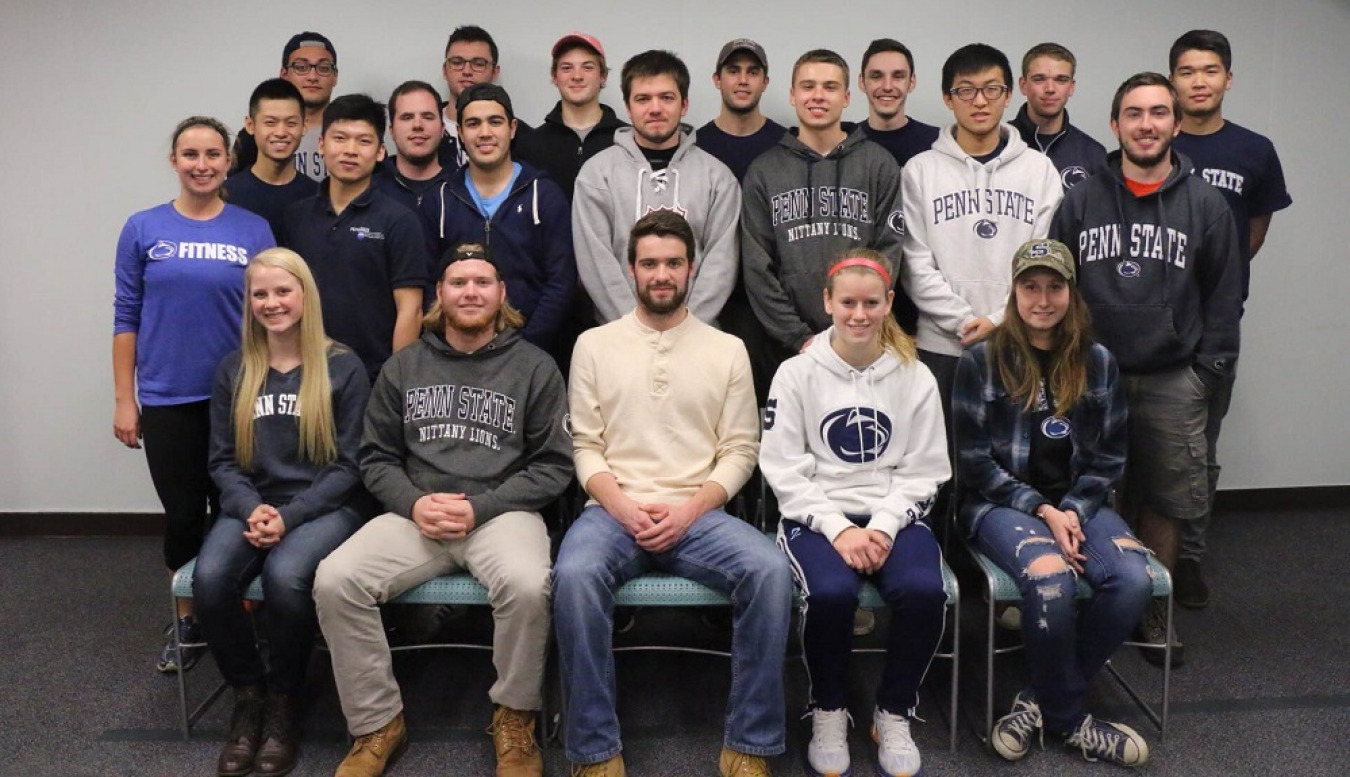
Team roster: Mitchell Proulx, Mechanical Engineering; Jason Cornelius, Aerospace Engineering; Kyle Dolf, Mechanical Engineering; Nader Abdelnour, Finance; Paul Caldwell, Industrial Engineering; Joseph Consoli, Mechanical Engineering; Adam DiPillo, Aerospace Engineering; Lindsey Hutterer, Public relations; Emily Kaercher, Mechanical Engineering; Daehyun David Lee, Chemical Engineering; Jhi Yong Loke, Mechanical Engineering; John Macnamara, Aerospace Engineering; Lucas Maass, Energy Business & Finance; Chloe Melnick, Engineering Science; Danielle Metzger, Marketing and Spanish; Joseph Miscioscia, Computer Science Engineering; Carlos Lopez Morales, Industrial Engineering; Patrick Nicodemus, Electrical Engineering; Chee Hau Teoh, Biomedical and Mechanical Eng; Robert Wasileski, Energy Business & Finance; Haochen Wu, Mechanical Engineering; Bolor-Erdene Zolbayar, Aerospace Engineering
Pennsylvania State University team meeting.
A group of Pennsylvania State University students watch a wind tunnel testing.
The deployment of the winning 2014 wind turbine.
TEAM NAME:
Penn State Collegiate Wind Competition Team
WHY WIND?
The Penn State team is participating in the 2016 U.S. Department of Energy Collegiate Wind Competition to apply what they learn in class to a real-world project. They are eager to get to work hands on with new techniques, gain new knowledge in their respective fields, and experiment with burgeoning technologies such as 3-D printing and digital systems.
PROJECT DESCRIPTION:
The Penn State Collegiate Wind Competition Team has been working to develop a business plan for its company, Winergize, with a product to be unveiled at the U.S. Department of Energy Collegiate Wind Competition 2016. The team's primary goal is to provide off-grid energy solutions through the use of wind energy. To achieve this goal, the team is designing and prototyping a small-scale wind turbine that can be easily deployed to provide power in very specific off-grid scenarios. In addition, the students aim to gain real-world experience through this project that will help them launch careers in the wind industry.
GAME PLAN:
The team has been organized generally as a club activity with broad participation from students representing 12 different majors and four colleges. Two team members were on the Penn State U.S. Department of Energy Collegiate Wind Competition 2015 team and have continued on as leaders for the engineering side of the team, while a business lead was also brought on to assist with the overall management of the team. Subgroups have formed under the management of these leads, meeting weekly at a minimum. Some team members participate in multiple subgroups. Weekly deliverables and active participation have been keys to the team’s success to date.
TEAM STRENGTHS:
The Penn State team finds strength in its membership crossing a wide variety of disciplines. Each team member has aligned their efforts with project tasks that both build upon their strengths and also their interests. They thus have a very dedicated and passionate team working cohesively together toward the common goal of winning the U.S. Department of Energy Collegiate Wind Competition 2016.
TEAM HURDLES:
The team has ordered the contests as follows in terms of least challenging to most challenging.
Turbine Performance Testing
The test turbine has been the least of the team’s challenges as a team thus far. There was a lot of work that needed to be done, but their design is coming together nicely. With two returning members from the 2015 competition, the test turbine competition has aligned well with the team.
Business Plan and Deployment Strategy
The challenge the team has faced is choosing a realistic and viable market. They have done a lot of research and project development to make sure they have chosen a good market.
Technical Design
The engineering team is working on the technical design of the market turbine and is on schedule to be completed before the competition.
Bonus Challenge
The team has done much initial brainstorming on the bonus challenge, but has a long way to go to fully tackle this challenge. Many decisions for this challenge are dependent on the chosen market and technical design, which are now further developed so they intend to make more progress in the coming months.
TEAM TAKEAWAY
The most important thing for the team is gaining hands-on experience dealing with real-world problems. Although not even halfway through the year, everyone on the team has learned something about business and technical design processes that will help them in their future endeavors.

